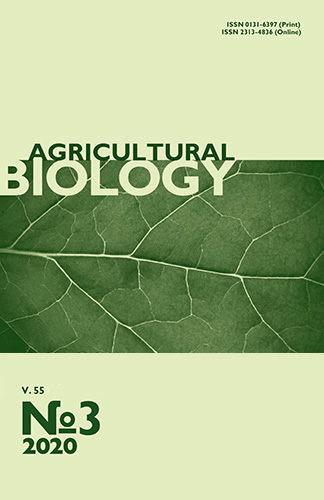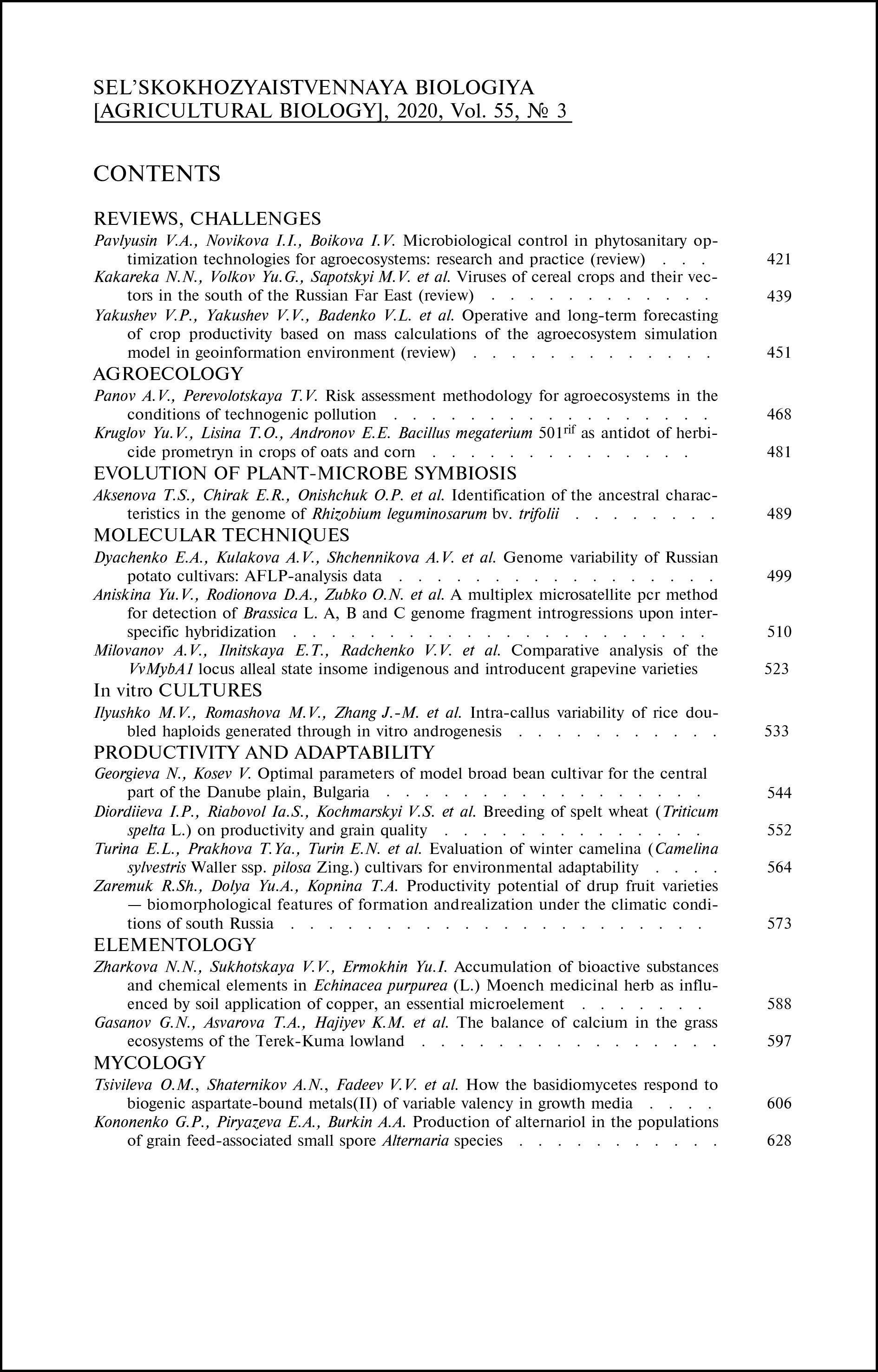doi: 10.15389/agrobiology.2020.3.564eng
UDC: 633.85:631.526.32:574.24
EVALUATION OF WINTER CAMELINA (Camelina sylvestris Waller ssp. pilosa Zing.) CULTIVARS FOR ENVIRONMENTAL ADAPTABILITY
E.L. Turina1, T.Ya. Prakhova2, E.N. Turin1, A.A. Zubochenco1,
V.A. Prakhov2
1Research Institute of Agriculture of Crimea, 150, ul. Kievskaya, Simferopol, Republic of Crimea, Russia 295493, e-mail turina_e@niishk.ru, schigortsovaelena@rambler.ru (✉ corresponding author), turin_e@niishk.ru, zubochenko_a@niishk.ru;
2Federal Research Center for Bast Fiber Crops, 1b, ul. Michurina, Lunino-1, Penza Province, Russia 442731, e-mail prakhova.tanya@yandex.ru, t.prakhova.pnz@fnclk.ru
ORCID:
Turina E.L. orcid.org/0000-0002-7791-3030
Zubochenco A.A. orcid.org/0000-0003-3393-9885
Prakhova T.Ya. orcid.org/0000-0002-7063-4784
Prakhov V.A. orcid.org/0000-0002-5469-5114
Turin E.N. orcid.org/0000-0003-1680-2828
Received August 18, 2019
Winter camelina (Camelina sylvestris Waller ssp. pilosa Zing.) is a promising oilseed crop that enjoys great popularity in the world because of high oil content and a wide range of uses. From the environmental point of view, winter camelina possesses phenotypic plasticity and seems to be particularly adapted to a wide range of soil and climatic conditions. Camelina is a cold-resistant and drought-tolerant plant. Spread of winter camelina cultivation and its productivity improvement depends on the genetic diversity of cultivars adapted to the conditions of the region of its cultivation, as well as on the genotype-environment interaction. In the presented work, it was first established that in the conditions of the Middle Volga and Steppe Crimea, winter camelina specimens are adaptable, stable and able to produce high yield of good quality. This allows us to involve these forms in breeding new varieties adapted for cultivation in both regions. The aim of the work is to evaluate the cultivars of winter camelina for environmental adaptability and stability in two contrasting agroecological regions, the Middle Volga Region (Penza Agricultural Research Institute) and the steppe zone of the Crimea (Research Institute of Agriculture of Crimea) in 2015-2017. Varieties of Camelina sylvestris of various ecogeographical origins were investigated. Cultivar Penzyak (Penza Agricultural Research Institute) served as a standard. This cultivar has been cultivated in the Crimea on an industrial scale since 2015. Winter hardiness of the studied cultivars in the fields of Penza was high and ranged between 89.5 % to 96.7 %, in the Crimean Peninsula territory it was 92.3-96.9 %. Various hardiness groups were identified: samples with high cold tolerance (more than 98 %), samples with the middle level of winter hardiness (90-95 %), and samples with low winter-tolerance (less than 90 %). Winter hardiness of the same samples varied within the range of 92.3-96.9 % under the Crimean environment. The highest level of winter hardiness was noted for the cultivar Baron and individual selection line 4156, which exceeded standard cultivar Penzyak by 0.8-1.0 %, respectively. The productivity of varieties in the Crimea was 1.64-1.83 t/ha. Seed oil content varied from 35.61 to 43.90 %. The highest content of fat in seeds was noted in varieties Baron and Kozyr (43.90 and 43.60 %). Realization of yield potential of winter camelina cultivars and samples in the forest-steppe zone of the Middle Volga and steppe zone of the Crimea was relatively high, 70.9-88.9% and 71.1-86.3%, respectively. The highest level of yield realization was identified for the cultivar Dikiy (86.3 % and 88.9 %). Two samples (Dikiy and individual selection line 3290) were the most effective in terms of productivity. Their productivity was 1.83-1.97 when cultivated in Penza Agricultural Research Institute, and 1.73-1.85 t/ha in Research Institute of Agriculture of Crimea. On average, cultivar Dikiy (88.9 g/m2) and individual selection line 3290 (85.4 g/m2) showed the highest level of adaptability to the conditions of both territories. The lowest adaptability criterion was identified for the individual selection line 4172 from Sverdlovsk and individual selection line 4175 from Czechoslovakia, the fitness coefficients amounted 56.3 and 59.6 g/m2, respectively. High adaptability of the samples (bi = 0.98-0.99 for Dikiy and bi = 0.96-0.95 for individual selection line 3290) allows their cultivation both in the Middle Volga and in Steppe Crimea. Low adaptability was noted for theindividual selection line 2219 (bi = 0.89) in the Penza region; in the Crimea, for the aforementioned individual selection line bi was 1.15.
Keywords: winter camelina, productivity, cultivation, region, Middle Volga, Crimea, oil content.
REFERENCES
- Zhuchenko A.A. Adaptivnaya sistema selektsii rastenii (ekologo-geneticheskie osnovy) [Adaptive plant breeding system (eco-genetic fundamentals)] . Moscow, 2001: 529, 539 (in Russ.).
- Joshi S.K., Ahamada S., Meher L.C., Agarwal A., Nasim M. Growth and yield response of Camelina Sativa to inorganic fertilizers and farmyard manure in hot semi-arid climate of India. Adv. Plants Agric. Res., 2017, 7(3): 1-6 CrossRef
- Ghamkhar K., Croser J., Aryamanesh N., Campbell M., Kon'kova N., Francis C. Camelina (Camelina sativa (L.) Crantz) as an alternative oilseed: molecular and ecogeographic analyses. Genome, 2010, 53(7): 558-567 CrossRef
- Imbrea F., Jurcoane S., Hălmăjan H.V., Duda M., Botoş L. Camelina sativa: a new source of vegetal oils. Romanian Biotechnological Letters, 2011, 16(3): 6263-6270.
- Katar D., Arslan Y., Subaşı İ., Tekirdağ Z., Fakültesi D. Ankara ekolojik koşullarında farklı ekim zamanlarının ketencik (Camelina sativa (L.) Crantz) bitkisinin yağ oranı ve bileşimi üzerine olan etkisinin belirlenmesi. Journal of Tekirdag Agricultural Faculty, 2012, 3: 84-90.
- Waraich E.A., Ahmed Z., Ahmad R., Ashraf M.Y., Saifullah, Naeem M.S., Rengel Z. Camelina sativa, a climate proof crop, has high nutritive value and multiple-uses: a review. Australian Journal of Crop Science, 2013, 7(10): 1551-1559.
- Moser B.R. Camelina (Camelina sativa L.) oil as biofueis feedstock: golden opportunity or false hope. Lipid technology,2010, 22(12): 270-273 CrossRef
- Zazulya L.N., Nagornov S.A., Romantsova S.V., Malakhov K.S. Dostizheniya nauki i tekhniki APK, 2009, 12: 58-60.
- Buyankin V.I. Masla i zhiry, 2008, 3: 19-22 (in Russ.).
- Dobre P., Jurcoane Ş. Camelina sativa — an oilseed crop with unique agronomic characteristics. In: Scientific Papers, Series A, Vol. LIV. Bucharest, 2011: 425-430.
- Sharma N. Assessment of biofuel potential in India. International Journal of Recent Scientific Research, 2017, 8: 17125-17127 CrossRef
- Wu X., Leung D. Orthogonal array design for biodiesel production optimization — using ultrasonic-assisted transesterification of Camelina sativa L. Crantz oil. Proc. of the World Renewable Energy Congress. Linköping, Sweden, 2011, V. 57: 79-86 CrossRef
- Sidorov E.A., Ukhanov A.P., Zelenina O.N. Izvestiya Samarskoi gosudarstvennoi sel'skokhozyaistvennoi akademii, 2013, 3: 49-54 (in Russ.).
- Mohammed Y.A., Chen C., Lamb P.F., Afshar R.K. Agronomic evaluation of camelina (Camelina sativa (L.) Crantz) cultivars for biodiesel feedstock. BioEnergy Research,2017, 10: 792-799 CrossRef
- Vinovets V.G., Lisnyak A.D., Ivanov M.V. Naukovo-tekhnіchnii byuleten' Іnstitutu olіinikh kul'tur NAAN, 2014, 20: 86-91 (in Russ.).
- Loshkomoinikov I.A., Kuznetsova G.N. Kormoproizvodstvo, 2009, 4: 24-27 (in Russ.).
- Ryabtseva N.A. Sel'skoe, lesnoe i vodnoe khozyaistvo, 2015, 1(40): 14-17 (in Russ.).
- Mostofa U.H., Nazrul I., Monjurul K., Noor H.M. Performance of rapeseed and mustard (Brassica sp.) varieties/lines in north-east region (Sylhet) of Bangladesh. Agricultural Research & Technology, 2016, 1(5): 001-006 CrossRef
- Bekuzarova S.A., Dulaev T.A. Novye netraditsionnye rasteniya i perspektivy ikh ispol'zovaniya, 2016, 12: 182-184 (in Russ.).
- Prakhova T.YA., Smirnov A.A., Prakhov V.A., Turina E.L., Kulinich R.A. Trudy Kubanskogo gosudarstvennogo agrarnogo universiteta, 2017, 66: 203-207 CrossRef (in Russ.).
- Campbell M. Camelina — an alternative oil crop. In: Biokerosene. M. Kaltschmitt, U. Neuling (eds.). Springer, Berlin, Heidelberg, 2018: 259-275 CrossRef
- FAO Data Dissemination. Available: http://www.fao.org/statistics/databases/ru/. No date.
- Galasso I., Manca A., Braglia L., Ponzoni E., Breviario D. Genomic fingerprinting of Camelina species using c TBP as molecular marker. American Journal of Plant Sciences, 2015, 6(8): 1184-1200 CrossRef
- Korolev K.P., Bome N.A. Evaluation of flax (Linum usitatissimum L.) genotypes on environmental adaptability and stability in the North-Eastern Belarus. Sel'skokhozyaistvennaya biologiya [Agricultural Biology], 2017, 3(52): 615-621 CrossRef
- Kil'chevskii A.V. Vestnik VOGiS, 2005, 4(9): 518-526 (in Russ.).
- Betancor M.B., Li K., Bucerzan V.S., Sprague M., Sayanova O.V., Usher S.L., Han L., Norambuena F., Torrissen O.J., Napier J.A., Tocher D.R., Olsen R.E. Oil from transgenic Camelina sativa containing over 25 % n-3 long-chain PUFA as the major lipid source in feed for Atlantic salmon (Salmo salar). British Journal of Nutrition, 2018, 119(12): 1378-1392 CrossRef
- Metodika provedeniya polevykh agrotekhnicheskikh opytov s maslichnymi kul'turami /Pod redaktsiei V.M. Lukomtsa [Methodology for field agrotechnical trials of oilseeds. V.M. Lukomts (ed.)]. Krasnodar, 2010 (in Russ.).
- Dospekhov B.A. Metodika polevogo opyta s osnovami statisticheskoi obrabotki rezul'tatov issledovanii [Field trial methodology with the basic data statistical processing]. Moscow, 1985 (in Russ.).
- Kil'chevskii A.V., Khotyleva L.V. Geneticheskie osnovy selektsii rastenii. Obshchaya genetika rastenii [Genetic basis of plant breeding. General plant genetics]. Minsk, 2008: 50-56 (in Russ.).
- Nettevich E.D. Doklady RASKHN, 2001, 3: 50-55 (in Russ.).
- Belenkevich O.A. Fiziologo-geneticheskie aspekty vzaimosvyazei mezhdu rasteniyami yarovogo yachmenya v monotsenoze [Physiological and genetic aspects of spring barley plant interaction in a monocenosis. Sel'skokhozyaistvennaya biologiya, 2002, 3: 57-61.
- Voss-Fels K.P., Stahl A., Wittkop B., Lichthardt C., Nagler S., Rose T., Chen T.W., Zetzsche H., Seddig S., Majid Baig M., Ballvora A., Frisch M., Ross E., Hayes B.J., Hayden M.J., Ordon F., Leon J., Kage H., Friedt W., Stützel H., Snowdon R.J. Breeding improves wheat productivity under contrasting agrochemical input levels. Nat. Plants, 2019, 5(7): 706-714 CrossRef
- Ceccarelli S., Grando S., Capettini F., Baum M. Barley breeding for sustainable production. In: Breeding major food staples /M.S. Kang, P. Priyadarshan (eds). Blackwell Publishing, Oxford, 2008: 193-225 CrossRef
- Reeves T.G., Thomas G., Ramsay G. Save and grow in practice. Maize, rice, wheat. A guide to sustainable cereal production. FAO, Rome, 2016.
- Diederichsen A., Rozhmina L., Kudrjavceva A. Variation patterns within 153 flax (Linum usitatissimum L.) genebank accessions based on evaluation for resistance to fusarium wilt, anthracnose and pasmo. Plant Genetic Resources, 2008, 6: 22-32 CrossRef












